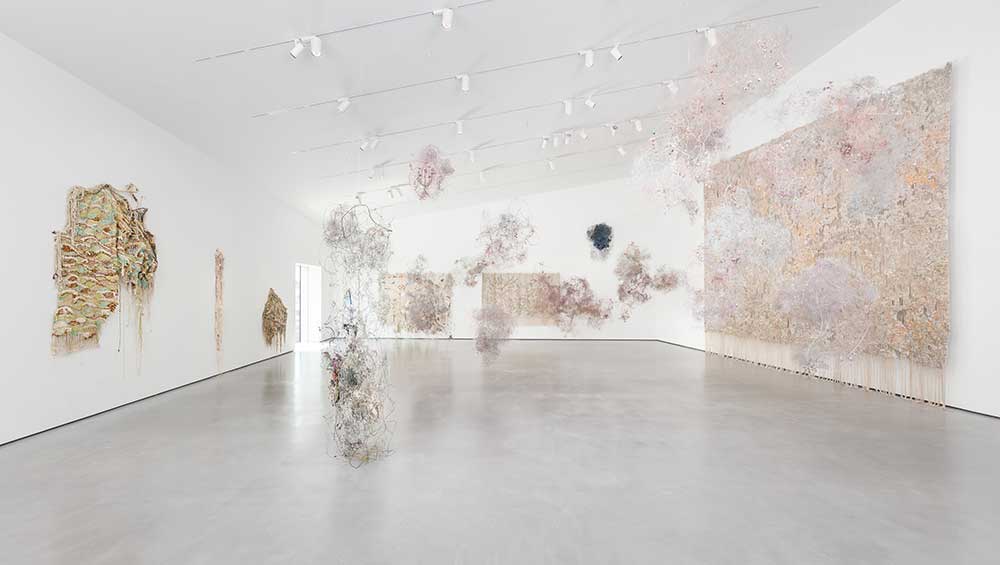
Igshaan Adams: Weerhoud, installation view, The Hepworth Wakefield, 22 June – 3 November 2024. Photo: Mark Blower.
The Hepworth Wakefield
22 June – 3 November 2024
by SABINE CASPARIE
There is a sense of hushed reverence when entering Igshaan Adams’s exhibition Weerhoud – I was not the only one to utter an astonished “Wow”. Adams’s first solo exhibition at the Hepworth Wakefield, it includes the two main kinds of work for which the artist has become known: his wall-based, hand-woven tapestries and his “dust clouds”: entangled messes of thin metal wire and string hanging from the ceilings at various heights, constellation-like. It is a hot, sunny day and the light bounces off the thousands of little beads woven into the tapestries and the balls of twirling metal wire and string.
Weerhoud is Afrikaans for “withheld”. It references the human body, where emotions are held and trauma is stored. Adams was born in Bonteheuwel, then a segregated suburb on the periphery of Cape Town. He has spoken in interviews about his tough childhood: a mixed heritage (a Muslim father and a Christian mother) and coming out as queer; living in an underprivileged area under apartheid, where violence often interrupted the more mundane moments of life. Working initially as a gardener, Adams was inspired by his uncle – the only openly gay man he knew growing up – to pursue art full time.
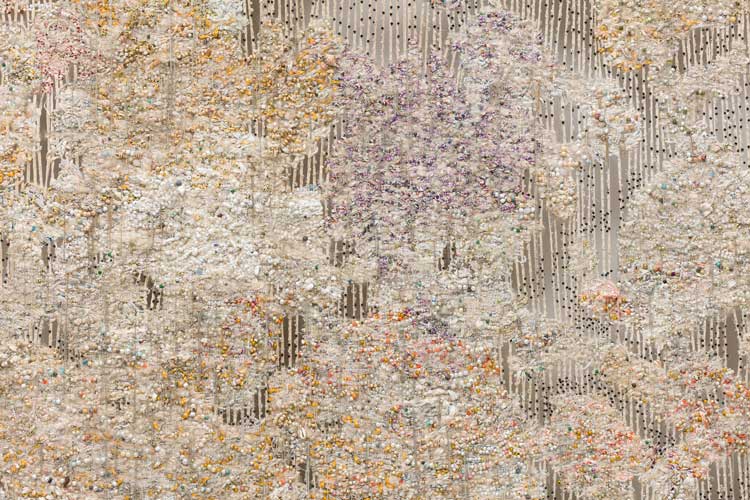
Igshaan Adams. Jaime-Lee, Byron, Dustin, Faroll, Lynette, 2024 (detail). Cotton twine, polypropylene and polyester rope, plastic, glass, wooden and stone beads, cotton fabric, mohair, silver and nickel chain and tiger tail wire. Installation view, The Hepworth Wakefield, 22 June – 3 November 2024. Photo: Mark Blower.
It is fitting then that Adams collaborated with this same uncle for the two large tapestries made especially for Weerhoud. Believing that dance and movement have a way of releasing stress and trauma from the body, Adams invited dancers from the Garage Dance Ensemble in the Northern Cape Province – the dance company established by his uncle, John Linden, and Linden’s partner, Alfred Hinkel. Laying out a canvas with wet paint covered by a plastic sheet, Adams recorded the dancers’ improvised movements, resulting in a monoprint that he used as the composition for the two tapestries. Jaime-Lee, Byron, Dustin, Faroll, Lynette, a monumental work that covers almost an entire wall, contains Adams’s trademark shades of white and beige and mauve and grey, but visible on closer look are subtle swaths of colour: purple, blue, pink, orange, formed by coloured beads. These are the areas where dancers made contact with the floor. Other areas are left unwoven, the negative space evoking a sense of fragmentation.
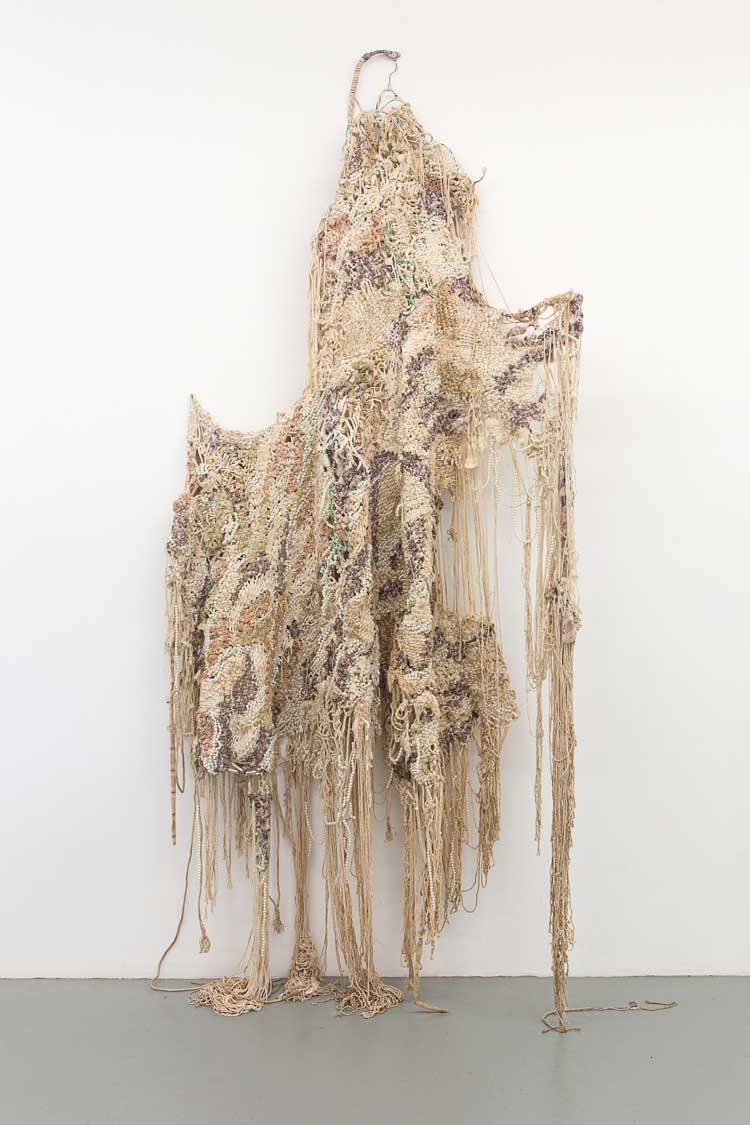
Igshaan Adams, Ouma, 2016. Courtesy of the artist. Private collection. © Igshaan Adams. Courtesy the artist, Thomas Dane Gallery and blank projects.
Around the room are older tapestries, which the artist reworked, as he says in the accompanying short film: “To make it feel that my work itself has gone through some kind of experience.” Some works are taken apart, showing the same unwoven areas as the new tapestries, others have been crumpled, transformed into almost sculptural forms. One is suspended from the ceiling and placed slightly away from the wall, like a religious screen or a moving altarpiece; another folds against the wall like a benign ghost, a small wooden stick protruding from one of its arms. The textile has a real human quality to it, the folds like curves, the holes like indentations. In one work, the particularly messy strands of thread dangling at the bottom reminded me of intestines.
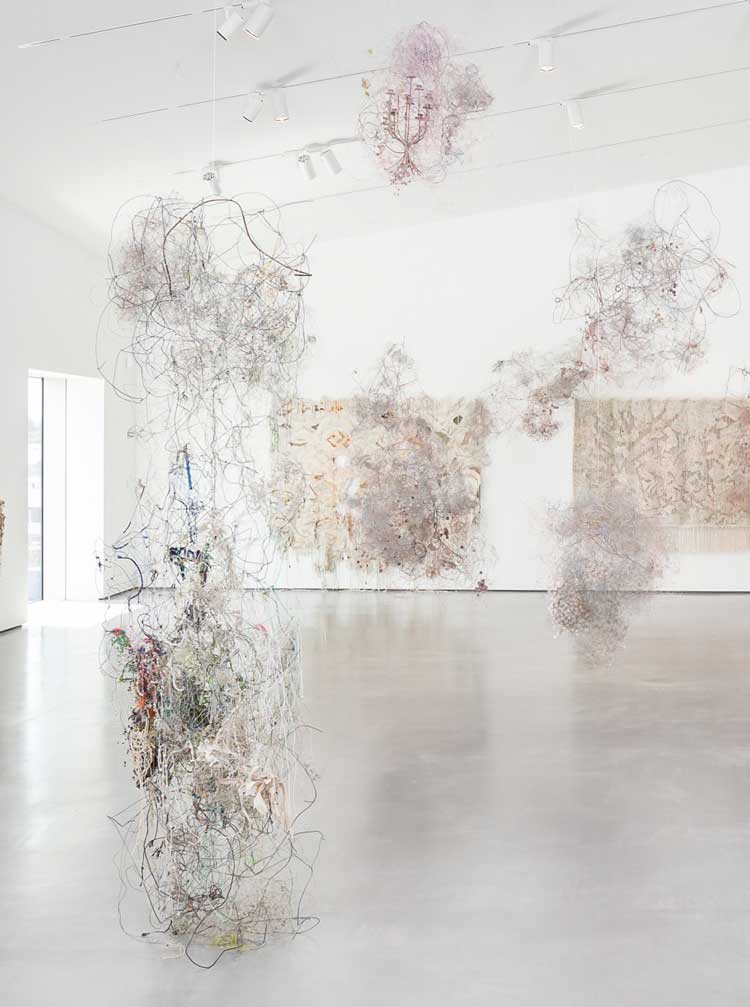
Igshaan Adams: Weerhoud, installation view, The Hepworth Wakefield, 22 June – 3 November 2024. Photo: Mark Blower.
Suspended throughout the space, as if in a dance with the wall-based works, are a series of new dust clouds. Intertwined with the ”balls” of thin metal wire and string are assembled elements such as sticks, beads, seashells and ribbon, as well as more functional objects, such as the plastic armatures of lamps, clothes hangers, a shower head. Originating from an experimental process, a playful habit of putting together some materials and things lying around in his studio, the clouds are like three-dimensional doodles, the practice itself another form of release. They reminded me of the clouds in cartoons when a character starts running, that same explosive energy, and yet they also feel calm and serene. One cloud contains a wooden chair pointing heavenwards, like a throne for an unnamed holy being. Another one is spray-painted in a moody blue, the colour of a sky at dusk, and placed high in a corner like a fuzzy, benign moon, its beads twinkling like little stars, casting its light over the celestial mass below.
-Installation-image-Mark-Bower.jpg)
Igshaan Adams. Untitled, 2019. Installation view, The Hepworth Wakefield, 22 June – 3 November 2024. Photo: Mark Blower.
Weerhoud is grander in scale and yet more introspective than Adams’s earlier exhibitions. He has always been interested in the marks left by humans moving through spaces, but where in Weerhoud the human imprint was created intentionally, under the direction of the artist, his earlier works explored the accidental imprints left on existing spaces, viewing them from a more racial, sexual and historical perspective. Probably his best-known works are the Desire Lines, a series of tapestries shown – among other places – at the 59th Venice Biennale, the composition of which is based on maps of the townships on the edges of Cape Town, its crisscrossing lines representing the informal paths made by many different people traversing the land, exploring the agency and hope that comes from deviating from expected behaviour. A more personal version is on show at ICA Boston, based on the paths Adams took from his home to his sports grounds – that hypermasculine space that was a site of tension for him.
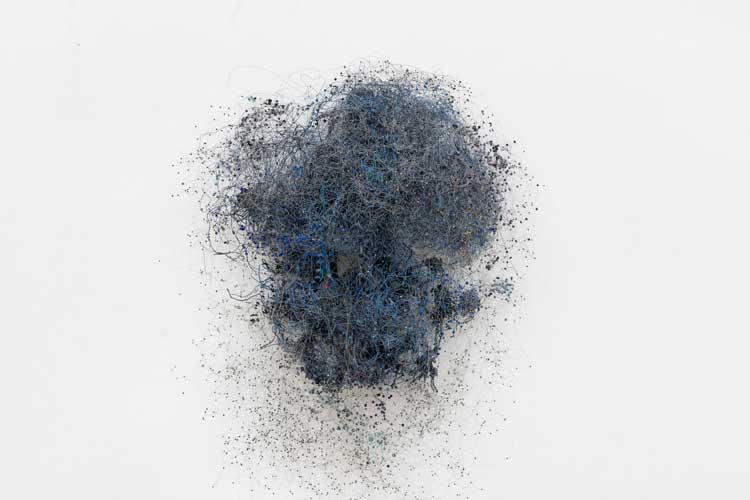
Igshaan Adams. Wolkies blaas, 2020. Courtesy of the artist. On loan from a private collection.
© Igshaan Adams. Courtesy the artist, Thomas Dane Gallery and blank projects. Photo: Mario Todeschini.
In Weerhoud, Adams is interested not so much in the scars as in the healing. There is a sense of repair in the reworking of the older works, bringing the dislodged threads together again in new forms that are less perfect but more honest. There is healing in the dance movements that formed the basis for the new tapestries, like a palimpsest for the future. A Hepworth staff member described to me how Adams’s team finished weaving some of the pieces only after they were installed in the space, an act that I imagine as essential to the final work. Looking at these tapestries, the audience isn’t thinking about the inhabitants of townships navigating their paths through dry earth and grass; instead, we are forging our own paths through this new celestial space that Adams has created. From passive to active, from witnessing to experiencing, this show makes the contact with Adams’s artworks much more direct, its concerns more metaphysical. “The universe itself is creativity,” the artist says in the Art Newpaper’s podcast A Brush with Igshaan Adams, “so it is in all of us.” Although I think everyone would agree that it is in Adams a whole lot more.
This, to me is the greatest achievement of this exhibition: to render at once the vastness of the universe, that great explosive realm of creation, and the messy, tiny, imperfect marks left by the humans who inhabit it. Artist, performer or visitor; whether in the sun-drenched hills surrounding Cape Town or in the cool interior of the Hepworth Wakefield amid the grey, industrial landscape. The past, the present and the future. It’s all there.